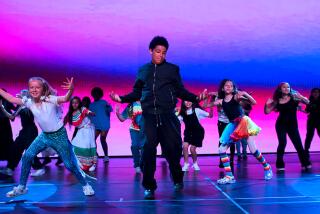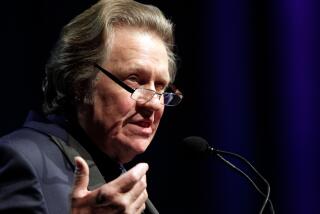Mark Morris moves with confidence
WITH TV fare that incorporates dance heightening audience awareness of the art form, Mark Morris would seem ideal to star in a reality show. Not only could cameras capture the peripatetic choreographer in rehearsals and on the road with his Mark Morris Dance Group, but they could also be privy to his exploits as opera director, musical conductor, occasional performer and, well, ubiquitous cultural figure and unabashed bon vivant.
These days, the career of this Manhattan resident with a rapier wit and mischievous smile, now 51, is thriving. Currently celebrating 27 years at the forefront of modern dance, his troupe will make its debut at the Dorothy Chandler Pavilion next weekend with three performances of “Mozart Dances.” The three-part work, a Southern California premiere, will feature accompaniment by pianists Garrick Ohlsson and Yoko Nozaki and a full orchestra led by Jane Glover.
First seen last year at New York’s Lincoln Center as part of a Mostly Mozart Festival celebration of the composer’s 250th birthday, “Mozart Dances” was performed again in August and broadcast live by PBS to an estimated 5 million viewers -- as many, one critic pointed out, as watch “America’s Next Top Model” each week. Not bad for a boy from Seattle who used to dance around his living room at age 15 to the music of Harry Partch.
“My work is popular because it’s good,” Morris announced on a scorching late-summer day in a Music Center conference room. Clad in shorts, blue denim shirt, beads, sandals and socks, the in-demand choreographer no longer sports either a mane of voluminous curls or a goatee, with the result that his face, still cherubic with piercing blue eyes, has a deceptively innocentquality.
“I also have an audience that’s bigger than a modern dance audience -- I’ve got a music audience who know they’re not going to get some tired old recording,” he added. “It’s show business, and two bad words in the modern dance world are ‘enjoy’ and ‘show.’ We’re entertainment and art -- and we’re very good at it.”
Indeed, because music is as essential to Morris’ work as light was to the Impressionists, the dance maker not only has collaborated with some of the world’s most elite performers, including cellist Yo-Yo Ma and pianist Emanuel Ax, but, 11 years ago, created the MMDG Music Ensemble to help him up his showbiz volume.
Dictating and driving the choreography, his musical settings have included Handel, Schumann, Monteverdi madrigals, Purcell, Tchaikovsky and Bartók. The latter’s Fourth String Quartet might have been thought undanceable until Morris created “All Fours” in 2003. Writing in The Times, Chris Pasles said that Morris had “made this thorny, intricate music more legible.”
In Mozart, a composer even Balanchine thought difficult to choreograph, Morris has once again struck gold. Recently honored with his third Bessie Award for “Mozart Dances,” he has put his stamp on a buoyant work that makes use of the piano concertos Nos. 11 and 27 and the Sonata in D for two pianos.
“I hadn’t choreographed much Mozart, but I worship him,” said the erstwhile bad boy of dance, whose latest prize was a $35,000 Samuel H. Scripps/American Dance Festival lifetime achievement award that he said he planned to use to remodel his kitchen. “But it wasn’t until I was in my 20s, with the operas, that I really got him.
“For this piece,” he continued, “I wanted a full evening of wonderful stuff that wasn’t familiar. No. 11 is the young Mozart, and No. 27 is less famous and the last he wrote.”
Completed by the Sonata in D to make for an all-piano night, the work has been acclaimed in London, Chicago and San Francisco as well as New York. The San Francisco Chronicle called it “an extraordinary undertaking, full of quicksilver emotions and darting ideas, mystery and menace, rigor and a shimmering momentum.”
Kick-starting the night is “Eleven,” a piece in which the women dominate, with the slightly built Lauren Grant serving as a solid soloist, her silky smooth turns and angular arm gestures seeming to embody the music. Grant, who has danced with Morris since 1996 and is married to fellow company member David Leventhal, attributes the work’s resonance to a number of factors.
“Each dance has a very distinct tone,” explained the 32-year-old, who teaches company class when Morris is unavailable, “yet Mark is able to make it a gestalt experience, a holistic unified approach, by having some recurring movement motifs. He’s able to capture abstract feelings that we have in life without telling a real story, but it reaches the human experience in an earthy way. He’s also a master with formations.”
Other observers have made comparisons to Morris’ 1988 magnum opus, “L’Allegro, il Penseroso ed il Moderato,” choreographed to the Handel oratorio of the same name. Morris, whose listening habits these days include savoring long periods of silence and barely audible recorded bird song, said he had not been surprised by any of the praise.
“The music is great,” he said. “Marty Pakledinaz’s costumes and Howard Hodgkin’s backdrop are beautiful. It’s also a big-scale performance, my company is gorgeous, and it doesn’t take 10 pages of program notes to understand my work to enjoy the show. How can you miss?”
Covering a lot of ground
WHAT might be regarded as hubris in lesser mortals is confidence in Morris, which he couples with a fierce work ethic and undeniable staying power. Having choreographed more than 120 works for his own company (“I like to make up new dances”), he is also a favorite of San Francisco Ballet, for which he has created six works since 1994. A seventh, with new music by John Adams and costumes by his old pal Isaac Mizrahi, is scheduled to bow in 2008 for the company’s 75th anniversary.Morris has also executed commissions for American Ballet Theatre and the Boston Ballet, among others, and his company maintains ties to several cities around the world. Its West Coast home in Berkeley plays host to biannual performances of “The Hard Nut” -- the choreographer’s ‘60s-inflected version of “The Nutcracker” -- in which Morris, who performs less these days than he used to, appears as a drunken party guest.
But the milestone he is most proud of is MMDG’s permanent headquarters. A five-story building in Brooklyn that opened in 2001, it houses a small theater, rehearsal space for the dance community, outreach programs and a school that not only offers dance classes to students of all ages but, since 2003, has had a class designed specifically for Parkinson’s sufferers. The course, initially offered once a month, has mushroomed in size and popularity and is currently held weekly.
“They take other classes now too,” said Morris, who also teaches ballet to his 19-member company. “It’s not the Parkinson’s Ghetto Class. It’s a mitzvah, actually, and turned into a fabulous thing to do.”
And Morris knows fabulousness. His devotion to music, which had already led to his choreographing opera productions for such institutions as English National Opera and the Metropolitan Opera, has lately opened the door to his directing and staging operas as well. Last year, he unveiled his hybrid production of Purcell’s 1691 “King Arthur” in London; it is scheduled to open in March at New York City Opera.
A collaboration with ENO and MMDG that breathed new life into the Baroque music of Purcell, the staging drew -- what else? -- more accolades. At its U.S. premiere in Berkeley, former New York Times dance critic John Rockwell dubbed Morris a “masterpiece-a-month man,” the production having come on the heels of the troupe’s 25th-anniversary celebration and “Mozart Dances.”
Morris scored yet another triumph in May at the Met when he helmed and choreographed Gluck’s “Orfeo ed Euridice.” And not content with only directing, as part of the company’s quarter-century festivities, he picked up a baton for the first time to conduct a performance of Vivaldi’s “Gloria,” a work he choreographed in 1981.
“I didn’t think I would do something so different, but conducting is really amazing,” said Morris, who plans to continue beating time with appearances in cities that include Irvine (in April), where his troupe will perform and he will conduct his 1989 adaptation of Purcell’s opera “Dido and Aeneas.”
Conducting is “very brainy and very interesting,” he said. “It’s also exhausting, and I’m drenched in sweat after four bars.”
But what’s a little sweat? Amid his globe-trotting, Morris has also been studying a newly discovered score of Prokofiev’s “Romeo and Juliet” in preparation for a version that will be premiered by his company next July at Bard College in upstate New York. He was unwilling to divulge the casting but, in typical curveball fashion, let on that the star-crossed lovers won’t die at the end. Talk about Romanticism!
As someone who approaches all his work with a similar sensibility, Morris said he’s a believer in the “magic” of creation.
“That’s what I like about show business and art -- it’s actually special,” he said. “You need to be able to turn a stick into a doll -- to have an imagination. Part of my job is to supply that. Look and listen. Be curious and get over yourself. It won’t hurt.”
More to Read
The biggest entertainment stories
Get our big stories about Hollywood, film, television, music, arts, culture and more right in your inbox as soon as they publish.
You may occasionally receive promotional content from the Los Angeles Times.










